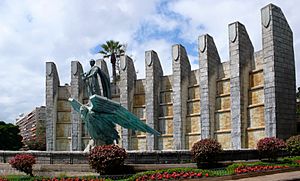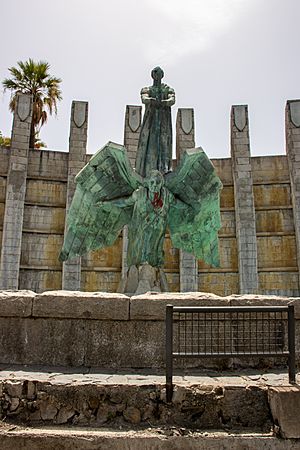Monument to Franco (Santa Cruz de Tenerife) facts for kids
 |
|
| Coordinates | 28°28′35″N 16°14′47″W / 28.476406°N 16.246262°W |
|---|---|
| Location | Santa Cruz de Tenerife, Spain |
| Designer | Juan de Ávalos |
| Material | Bronze, stone |
| Height | 14 m |
| Opening date | 17 March 1966 |
| Dedicated to | Francisco Franco |
The Monument to Victory, also known as Ángel de la Victoria (which means "Angel of Victory" in Spanish), is a famous public artwork. People often call it the Monument to Franco. You can find it in Santa Cruz de Tenerife, a city in Spain. This monument was created by Juan de Ávalos to honor Francisco Franco, an important leader in Spanish history.
Contents
About the Monument
This large monument stands where the Rambla de Santa Cruz and Avenida de Anaga roads meet. It is a striking sight for anyone visiting the area.
Design and Symbolism
The monument features a bronze sculpture group. It shows a winged angel, which represents the Dragon Rapide airplane. This plane was important because it carried Franco from the Canary Islands to Africa at the start of a major historical event in 1936.
Standing over the angel is a male figure. This figure represents Franco himself, shown as a "saviour." He holds a sword shaped like a Christian cross, pointing downwards.
Size and Location
The entire sculpture sits in the middle of a large, almost round pond. This pond is about 30 meters (nearly 100 feet) wide. Behind the main figures, there is a tall wall that partly encloses them. This wall reaches a height of 14 meters (about 46 feet).
Construction and Cost
The artist Juan de Ávalos began working on the monument in 1964. It was officially shown to the public on March 17, 1966. Building this monument cost about 8.1 million pesetas, which was a lot of money back then.
Many people helped pay for it. Around 80,000 individuals donated money, mostly small amounts like 1 to 5 pesetas. Today, the monument is valued at about €45 million by the Juan de Ávalos Foundation.
Recent Events and Debates
In November 2016, the monument was vandalized. It was covered in red paint, and a message saying "antifascismo" (meaning "anti-fascism") was written on it.
There is an ongoing discussion about whether the monument should be removed. Some people want it taken down because of a law called the Law of Historical Memory. Others believe it should stay because it is an important piece of art and has cultural value. This debate shows how different people view historical monuments.
See also
 In Spanish: Monumento a Su Excelencia el Jefe del Estado para niños
In Spanish: Monumento a Su Excelencia el Jefe del Estado para niños


